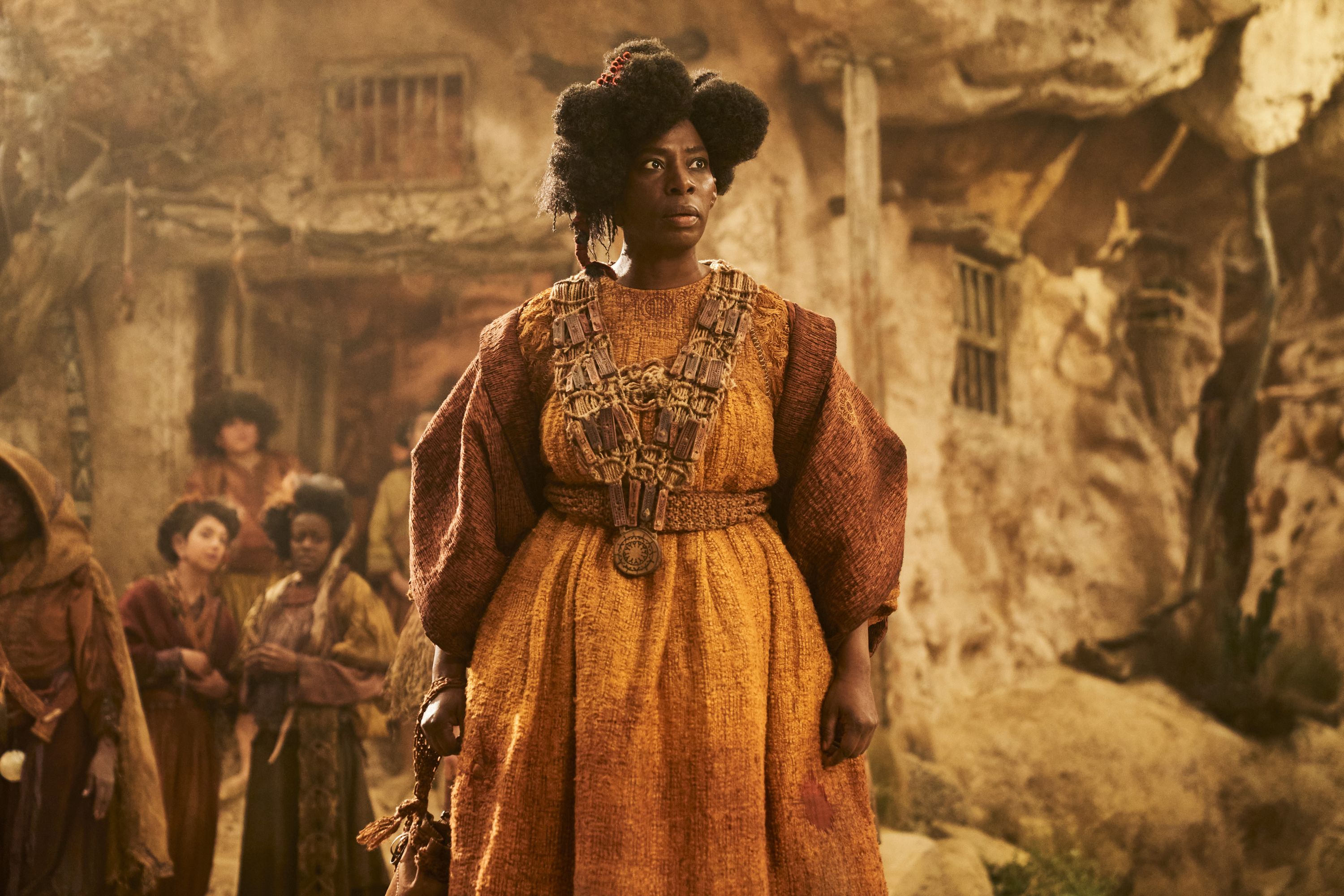
This week, The Lord of the Rings: The Rings of Power expanded significantly on its depiction of ancient halflings, and in doing so gave me a great gift.
By introducing the concept of Sûza-t, The Rings of Power let me look my co-workers straight in the (video call) eyes and explain that the heroes of The Lord of the Rings are actually called Maura Labingi and Banazîr Galpsi.
[Ed. note: This piece contains spoilers for The Lord of the Rings: The Rings of Power season 2 episode 4.]
In the course of this week’s episode, our harfoot lasses Nori and Poppy (Markella Kavenagh and Megan Richards) encounter another society of halflings — the stoors. They’re treated with suspicion until the stoor leader, Gundabel (Tanya Moodie), realizes that they’re all long-estranged family, in a way. It turns out that Nori and Poppy’s harfoot band are the descendants of a group of adventurous stoors, who set off ages ago in search of a prophesied paradise of abundant rivers and green growing fields, called Sûza-t.
What is Sûza-t?

This one’s easy: Sûza-t is the land of abundant rivers and green growing fields that halflings settled roughly 1,300 years before the events of The Hobbit and The Lord of the Rings, uniting the harfoots, stoors, and fallohides into a single halfling culture. We know it by its English name: the Shire.
The episode doesn’t explain that Sûza-t is synonymous with the Shire, because these hobbits haven’t gotten there yet. But there’s another reason that’s really going to bake your noodle: Sûza-t isn’t an ancient name for paradise that was replaced with “the Shire” once hobbits settled there. It’s the current name for the Shire. Because the The Lord of the Rings was “translated” into English.
Get on J.R.R. Tolkien’s level
Writing fantasy epics was never Tolkien’s day job, even when his books became bestsellers. But when we call him an “English professor,” it conjures up students appreciating great works of contemporary fiction — and that wasn’t Tolkien’s specialty at all. Tolkien taught historical English linguistics, not English literature, specifically Modern English’s precursors, Middle and Old English. He thought Shakespeare was overrated, and the most recent texts on his syllabus were from the 14th century. Before he wrote The Hobbit, his biggest claim to fame was as the foremost Beowulf scholar and translator of his generation.
It was this specialization, born from his lifelong passion for etymology, that led to the creation of Middle-earth. Tolkien didn’t start with a hobby of writing fantasy novels — he started with a hobby of inventing fictional languages. The history of the elves, with their migrations, conflicts, and schisms, was created to give the history behind their detailed etymological shifts. The languages weren’t invented for his stories, the stories were invented for the languages.

Tolkien brought this conceptual frame, the frame of his day job, to the text of The Hobbit and The Lord of the Rings themselves. Both stories are, as quietly stated within their own text, translations of The Red Book of Westmarch, history of the War of the Ring written by the hobbits who were there: Bilbo, Frodo (that’s the book Frodo’s writing in Peter Jackson’s movies), and Sam. And the hobbits didn’t write it in English. They wrote it in the totally fictional common tongue they shared with their neighboring human societies, Westron.
Tolkien “translated” a great deal of the Westron place names and proper nouns into corresponding English terms or new words with the same roots as the “original” Westron names. Which is to say: Tolkien wrote The Lord of the Rings in English, but he couldn’t help inventing yet another line of etymological history while he was at it.
He created the Westron word sûza, to mean a province or set area of land, and -t to have the same function as “the.” Thus, the Westron term for the Shire is Sûza-t. Frodo’s name contained the real Germanic root frod-, meaning “wise,” so Tolkien invented the Westron root maur- to mean the same thing. “Samwise” derives from roots meaning “simpleminded,” so he invented the Westron term banazîr with the same meaning. In Tolkien’s Westron, kali means to be happy or joyful, while razar means apple.
What does this mean for Middle-earth?
Well, on the one hand, nothing! The fact is that Tolkien wrote The Lord of the Rings in English. He was just a compulsive language inventor, and exercised that interest in the appendices of The Return of the King by providing fictional “translation notes” on the character names, just as he would have done for any of his academic studies. This is just how he had fun.
But on the other hand, it’s also an invitation to view The Lord of the Rings as something other than a perfect text. Tolkien was renowned as a translator, and he would have been very aware that any translation of a text contains at least a little bias, omission, mistranslation, and loss of cultural context. It’s an invitation to read between the lines.
But also, and perhaps most importantly, it means that Frodo Baggins, Sam Gamgee, Merry Brandybuck, and Pippin Took aren’t their names.
The hobbit heroes of The Lord of the Rings are Maura Labingi, Ban Galpsi, Kali Brandagamba, and Razar Tûk.
Source:https://www.polygon.com/lotr-rings-of-power/447883/rings-of-power-episode-4-shows-that-however-nerdy-you-think-j-r-r-tolkien-was-he-was-nerdier





